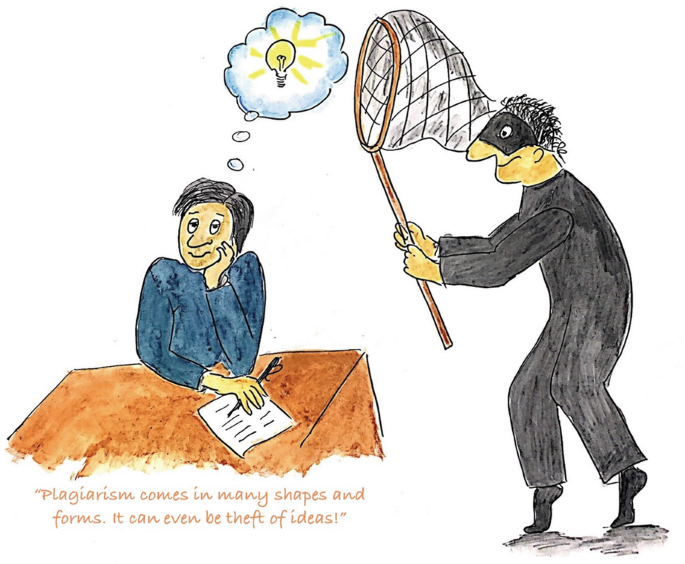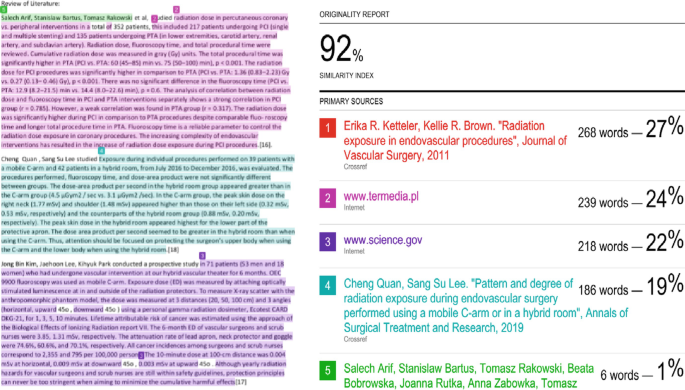Abstract
The word ‘Plagiarism’ has been derived from the Latin word ‘Plagiare’ which means ‘to kidnap or abduct’. In scientific literature, it means the ‘wrongful appropriation’ and ‘stealing and publication’ of another author’s ‘language, thoughts, ideas, or expressions’ and depicting it as one’s own creative work. Plagiarism amounts to academic untruthfulness and a breach of journalistic integrity [1].
Copying from one it’s plagiarism, copying from two it’s research.
Wilson Mizner, American playwright, raconteur and entrepreneur (1876–1933).
You have full access to this open access chapter, Download chapter PDF
Similar content being viewed by others
1 What Is Plagiarism?
The word ‘Plagiarism’ has been derived from the Latin word ‘Plagiare’ which means ‘to kidnap or abduct’. In scientific literature, it means the ‘wrongful appropriation’ and ‘stealing and publication’ of another author’s ‘language, thoughts, ideas, or expressions’ and depicting it as one’s own creative work. Plagiarism amounts to academic untruthfulness and a breach of journalistic integrity [1].

2 Why Is Plagiarism So Rampant in India?
There are many reasons why plagiarism is common in India. There is the compulsory thesis before the final postgraduate examination which students need to finish in time so they find the ‘cut and paste’ technique to be a convenient shortcut to writing the manuscript or even doing the research. The other reason is that they have never attended research methodology workshops where plagiarism is discussed. They do not know that plagiarism is a serious offence that can be punished with suspension or expulsion from their institution in other countries. The unfamiliarity with the English language, lax checking by their supervisors and an absence of punishment are other reasons for this. Plagiarism reflects the poor standards of our medical publications [2]. However, it is also a global phenomenon and not unique to India [3].
3 What Action Can Be Taken Against you if your Manuscript Is Found to be Plagiarized?
All types of plagiarism can attract disciplinary action which may range from removing the published paper, legal and monetary repercussions and academic and professional damage to your reputation. All good journals and many universities check the manuscripts for this through online checking systems which are now widely available. We should have a ‘zero tolerance policy’ for such acts.
4 Does Plagiarism Apply Only to Written Text?
No, this statement is not true as plagiarism applies to text in manuscripts as well as images, clinical photographs, tables, graphs, and pictorial data.
5 Is There a Gazette of India Notification on Plagiarism?
Yes, the University Grants Commission (UGC) has a regulation, dated 31 July 2018 regarding promotion in academic institutions and on the prevention of plagiarism. It defines 20 terms like plagiarism, author, academic integrity, script, source, etc. It also describes a penalty for a plagiarized thesis and dissertation. It also mentions that all students should submit a soft copy of their theses or dissertations to some central information and library centre [4].
6 What Is the UGC’s Classification of Plagiarism?
In 2018, it classified plagiarism in educational institutions into various levels. If similarity is less than 10%, no action is taken. However, if the level of plagiarism increases above this, the action given below is recommended [4, 5].
-
Level 1—10–40% similarity. No marks or credits shall be awarded for the plagiarized script. The revised manuscript should be re-submitted within 6 months.
-
Level 2—40–60% similarity. No marks or credits shall be awarded for the plagiarized script. The student is entitled to resubmit the revised script after 1 year but not exceeding 18 months.
-
Level 3—above 60% similarity. No marks or credits shall be awarded for the plagiarized script. Registration for the course itself is cancelled.
7 What Are the Sections in Articles which Are Excluded from Plagiarism Checks?
The areas which are excluded are: [4].
-
Quoted statements (quoted work can be reproduced with all the necessary permissions).
-
References/Bibliography.
-
Table of Contents.
-
Preface/Acknowledgements.
-
Standard symbols/Generic terms.
8 What Do Words Quote, Paraphrase and Similarity Mean?
A quote is using or repeating the same words as in the original text. If this is done it should appear under inverted commas. For example, Hippocrates stated ‘I will follow that system of regimen which, according to my ability and judgment, I consider for the benefit of my patients, and abstain from whatever is deleterious and mischievous’.
A Paraphrase is rewriting the original idea in our own words. While doing paraphrasing the central concept or the meaning of the text is not changed.
Similarity is copied text and is like the original text. The original and the text written are exactly the same.
9 What Are the Various Types of Plagiarism? [6,7,8]
-
1.
Total or Complete Plagiarism
This depicts a severe form of plagiarism. In this, the investigator passes off someone else’s script or study as his own, and submits it under his own name.
-
2.
Direct Plagiarism
Direct or verbatim plagiarism is a type of complete plagiarism when one section of the text is copied rather than the whole text.
-
3.
Self- or Auto-plagiarism
Auto-plagiarism, also known as self-plagiarism or duplication, happens when authors reuse sizeable portions of their previously published work without attribution.
-
4.
Paraphrasing plagiarism
This is the most common type of plagiarism seen among students. It involves the use of the original author’s manuscript after making some minor changes in the sentences and creating a new article.
-
5.
‘Cut and paste’ plagiarism
This type of plagiarism is becoming common among students because of the easy accessibility of scientific information on the internet.
-
6.
Mosaic/patchwork plagiarism
Mosaic plagiarism may be difficult to detect because it interposes someone else’s a few sentences or paragraphs within the text.
-
7.
Accidental Plagiarism
This can be either intended or unintended. Even for this, there is no excuse and the consequences are often the same.
10 How Can we Check for Plagiarism?
Many sites are now available - free or paid. Grammarly©, Whitesmoke©, Prewriting aid©, Duplichecker©, Plagarism © Check.org©C, Quetext ©, small SEO plagiarism checker©, copytext©, viper©, checkforplagiarism.net©, Wordpress Plugin©, Plagium©, etc.
11 How Does a Plagiarism Report Appear?
Once a check is done, the report looks similar to the Fig. 24.1. The lines and sentences which have been copied are highlighted in various colours as is the source from which it has been copied.
12 How Much Plagiarism Is Usually Allowed for a Paper to Be Accepted?
When it is an original paper, the author should aim at zero plagiarism. However, in many journals, a similarity of up to 15% is allowed. For a chapter in a book, this limit is about 5% and in a thesis, less than 10% is accepted.
13 What Is the Difference between Plagiarism and Copyright Infringement?
Plagiarism is claiming credit for a work you did not do or using someone else’s work without proper attribution.
Copyright infringement is a broad term covered under the law. In this, an author uses someone else’s work without obtaining their permission.
14 What Are the Five Rules for Avoiding Plagiarism?
-
Plan to finish your project well in time before submission.
-
Recognize the concept behind the manuscript you need to cite.
-
Never do ‘copy–paste’; it seems to be a shortcut but eventually it takes double the time to correct the mistakes.
-
Use your own language to build up the manuscript.
-
Use an online plagiarism device to check before final submission.
15 Conclusions
-
Plagiarism is a type of research delinquency that consists of copying someone else’s work or idea without giving him proper credit.
-
Plagiarism extends not only to the text but also to tables, charts and pictures.
-
An awareness about the risks of plagiarism is low among the students and researchers in developing countries.
-
To avoid the copy–paste culture, students should be instructed to read articles completely and carefully and then write a paper in their own words.
References
Sinha R, Singh G, Kumar C. Plagiarism and unethical practices in literature. Indian J Opthal. 2009;57:481–5.
Juyal D, Thawani V, Thaledi S. Rise of academic plagiarism in India: reasons, solutions and resolution. Lung India. 2015;32:542–3.
Gasparyan AY, Nurmashev B, Seksenbayev B, Trukhachev VI, Kostyukova EI, Kitas GD. Plagiarism in the context of education and evolving. J Korean Med Sci. 2017;32:1220–7.
Promotion of Academic Integrity and Prevention of Plagiarism in Higher Educational Institutions) Regulations, 2018 (lasted accessed 27th March 20202). Available on https://www.ugc.ac.in/pdfnews/7771545_academic-integrity-Regulation2018.pdf.
Kadam D. Academic integrity and plagiarism: the new regulations in India. Indian J Plast Surg. 2018;51:109–10.
Fred HL, Scheid MS. Egregious plagiarism: more than misconduct. Tex Heart Inst J. 2017;44:7–8.
Winsett RP. The importance of self-plagiarism in publication. Prog Transplant. 2017;27:327–8.
Weems M. Plagiarism in review. Pediatr Rev. 2017;38:3–5.
Author information
Authors and Affiliations
Rights and permissions
Open Access This chapter is licensed under the terms of the Creative Commons Attribution 4.0 International License (http://creativecommons.org/licenses/by/4.0/), which permits use, sharing, adaptation, distribution and reproduction in any medium or format, as long as you give appropriate credit to the original author(s) and the source, provide a link to the Creative Commons license and indicate if changes were made.
The images or other third party material in this chapter are included in the chapter's Creative Commons license, unless indicated otherwise in a credit line to the material. If material is not included in the chapter's Creative Commons license and your intended use is not permitted by statutory regulation or exceeds the permitted use, you will need to obtain permission directly from the copyright holder.
Copyright information
© 2022 The Author(s)
About this chapter
Cite this chapter
Nundy, S., Kakar, A., Bhutta, Z.A. (2022). How to Check for Plagiarism?. In: How to Practice Academic Medicine and Publish from Developing Countries?. Springer, Singapore. https://doi.org/10.1007/978-981-16-5248-6_24
Download citation
DOI: https://doi.org/10.1007/978-981-16-5248-6_24
Published:
Publisher Name: Springer, Singapore
Print ISBN: 978-981-16-5247-9
Online ISBN: 978-981-16-5248-6
eBook Packages: MedicineMedicine (R0)





